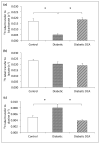Increasing Pyruvate Dehydrogenase Flux as a Treatment for Diabetic Cardiomyopathy: A Combined 13C Hyperpolarized Magnetic Resonance and Echocardiography Study
- PMID: 25795215
- PMCID: PMC4516266
- DOI: 10.2337/db14-1560
Increasing Pyruvate Dehydrogenase Flux as a Treatment for Diabetic Cardiomyopathy: A Combined 13C Hyperpolarized Magnetic Resonance and Echocardiography Study
Abstract
Although diabetic cardiomyopathy is widely recognized, there are no specific treatments available. Altered myocardial substrate selection has emerged as a candidate mechanism behind the development of cardiac dysfunction in diabetes. As pyruvate dehydrogenase (PDH) activity appears central to the balance of substrate use, we aimed to investigate the relationship between PDH flux and myocardial function in a rodent model of type 2 diabetes and to explore whether or not increasing PDH flux, with dichloroacetate, would restore the balance of substrate use and improve cardiac function. All animals underwent in vivo hyperpolarized [1-(13)C]pyruvate magnetic resonance spectroscopy and echocardiography to assess cardiac PDH flux and function, respectively. Diabetic animals showed significantly higher blood glucose levels (10.8 ± 0.7 vs. 8.4 ± 0.5 mmol/L), lower PDH flux (0.005 ± 0.001 vs. 0.017 ± 0.002 s(-1)), and significantly impaired diastolic function (transmitral early diastolic peak velocity/early diastolic myocardial velocity ratio [E/E'] 12.2 ± 0.8 vs. 20 ± 2), which are in keeping with early diabetic cardiomyopathy. Twenty-eight days of treatment with dichloroacetate restored PDH flux to normal levels (0.018 ± 0.002 s(-1)), reversed diastolic dysfunction (E/E' 14 ± 1), and normalized blood glucose levels (7.5 ± 0.7 mmol/L). The treatment of diabetes with dichloroacetate therefore restored the balance of myocardial substrate selection, reversed diastolic dysfunction, and normalized blood glucose levels. This suggests that PDH modulation could be a novel therapy for the treatment and/or prevention of diabetic cardiomyopathy.
© 2015 by the American Diabetes Association. Readers may use this article as long as the work is properly cited, the use is educational and not for profit, and the work is not altered.
Figures





References
-
- Morrish NJ, Wang SL, Stevens LK, Fuller JH, Keen H. Mortality and causes of death in the WHO Multinational Study of Vascular Disease in Diabetes. Diabetologia. 2001;44(Suppl 2):S14–21. - PubMed
-
- Aneja A, Tang WH, Bansilal S, Garcia MJ, Farkouh ME. Diabetic cardiomyopathy: insights into pathogenesis, diagnostic challenges, and therapeutic options. The American journal of medicine. 2008;121:748–57. - PubMed
-
- Fein FS. Diabetic cardiomyopathy. Diabetes care. 1990;13:1169–79. - PubMed
Publication types
MeSH terms
Substances
Grants and funding
LinkOut - more resources
Full Text Sources
Other Literature Sources
Medical
Research Materials

